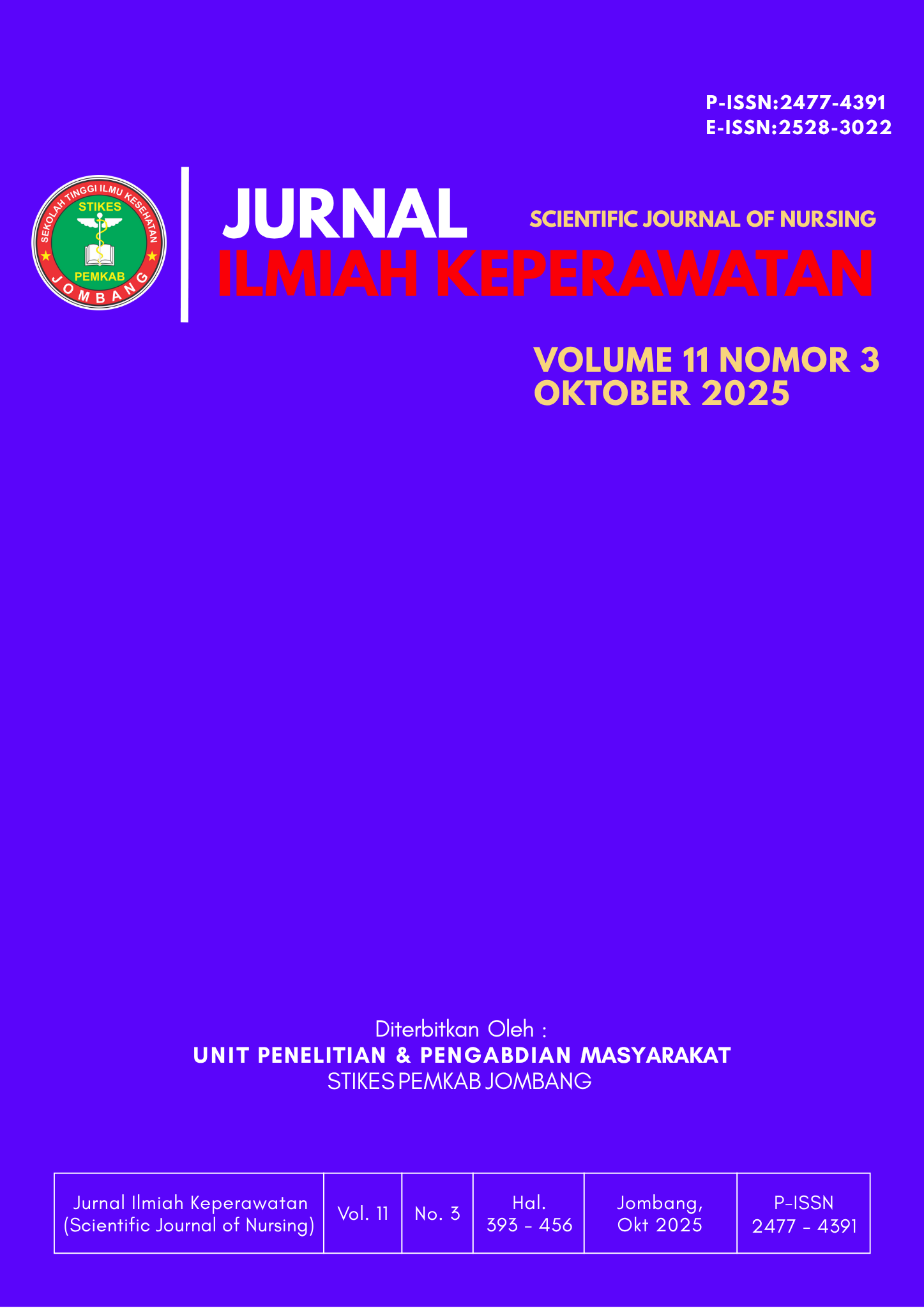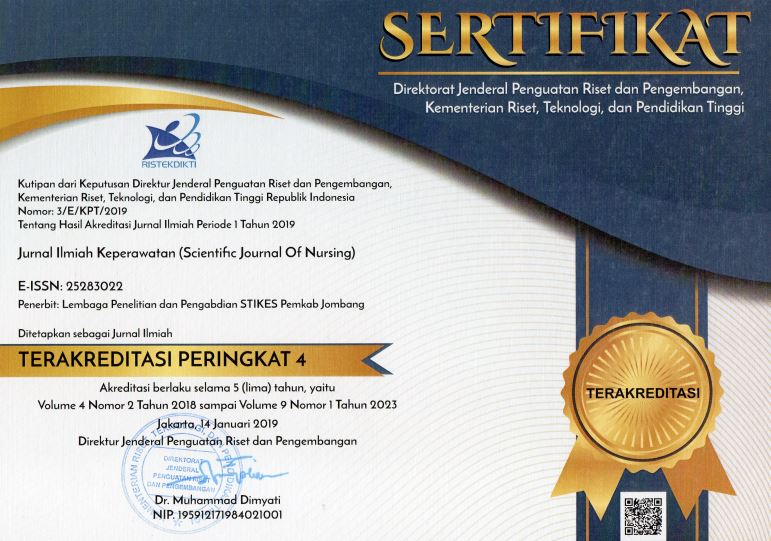Penerapan Theory of Planned Behaviour pada asuhan keperawatan pasien limfoma: Clinical case report
Application of the Theory of Planned Behaviour in nursing care for lymphoma patients: A clinical case report
DOI:
https://doi.org/10.33023/jikep.v11i3.2597Keywords:
Lymphoma exercise, Theory of Planned Behavior, patient with LymphomaAbstract
Pasien limfoma sering mengalami berbagai tanda dan gejala yang dapat mempengaruhi kualitas hidup mereka secara signifikan. Penelitian ini bertujuan untuk menerapkan Theory Of Planned Behaviour pada asuhan keperawatan pasien Limfoma. Pendekatan ini menekankan pentingnya sikap, norma subjektif, dan kontrol perilaku yang dirasakan dalam membentuk diagnosis keperawatan. Dalam konteks pasien limfoma, pemahaman tentang faktor-faktor dari Planned of Behavior yakni sikap terhadap perilaku, norma subjektif, dan persepsi kontrol perilaku dapat membantu mengidentifikasi intervensi yang efektif untuk meningkatkan kepatuhan terhadap pengobatan, adopsi gaya hidup sehat, dan partisipasi dalam perawatan tindak lanjut. Kerangka kerja ini dapat meningkatkan pemahaman dan meningkatkan perawatan pasien. Metode penelitian yang digunakan adalah pendekatan studi kasus. Hasil penelitian menunjukkan Penerapan Theory of Planned Behavior memungkinkan perawat untuk memberikan perawatan secara holistik yang melibatkan berbagai aspek kehidupan pasien limfoma termasuk fisik, emosional, sosial, spiritual dan kultural. Dengan memahami konsep Theory of Planned Behavior, perawat dapat mengenali bahwa didalam perubahan kebiasaan perilaku pasien itu membutuhkan perencanaan, dimana dari sikap menerima sampai menjadi suatu kebiasaan melakukan terapi itu membutuhkan proses dan perlu mendapat dukungan baik dari keluarga maupun tenaga kesehatan sehingga dapat mencapai goals dan outcome yang diharapkan.
Downloads
References
Cornor, M. (2020). Theory of Planned Behavior. In Handbook of Sport Psychology (pp. 1-18). John Wiley & Son.
Elshahat, S., Treanor, C. & Donnelly, M. Factors influencing physical activity participation among people living with or beyond cancer: a systematic scoping review. Int J Behav Nutr Phys Act 18, 50 (2021). https://doi.org/10.1186/s12966-021-01116-9
Fischetti, F., Greco, G., Cataldi, S., Minoia, C., Loseto, G., & Guarini, A. (2019). Effects of physical exercise intervention on psychological and physical fitness in lymphoma patients. Medicina (Lithuania), 55(7). https://doi.org/10.3390/medicina55070379
Huang, J., Pang, W. S., Lok, V., Zhang, L., Lucero-Prisno, D. E., Xu, W., Zheng, Z. J., Elcarte, E., Withers, M., & Wong, M. C. S. (2022). Incidence, mortality, risk factors, and trends for Hodgkin lymphoma: a global data analysis. Journal of Hematology and Oncology, 15(1). https://doi.org/10.1186/s13045-022-01281-9
Jamil, A., & Mukkaalla, S. K. (2023, July 17). Lymphoma. Https://Www.Ncbi.Nlm.Nih.Gov/Books/NBK560826/.
Kaseb, H., & Babiker, H. M. (2023, June 23). Hodgkin Lymphoma. Https://Www.Ncbi.Nlm.Nih.Gov/Books/NBK499969/.
Munir, F., Hardit, V., Sheikh, I. N., AlQahtani, S., He, J., Cuglievan, B., Hosing, C., Tewari, P., & Khazal, S. (2023). Classical Hodgkin Lymphoma: From Past to Future—A Comprehensive Review of Pathophysiology and Therapeutic Advances. In International Journal of Molecular Sciences (Vol. 24, Issue 12). Multidisciplinary Digital Publishing Institute (MDPI). https://doi.org/10.3390/ijms241210095
Norman, P., & Conner, M. (2016). Health behavior. In The Curated Reference Collection in Neuroscience and Biobehavioral Psychology (pp. 1–37). Elsevier Science Ltd. https://doi.org/10.1016/B978-0-12-809324-5.05143-9
Raiesifar, A., Maleki, R., Sharifi, N., Darabi, F., & Hojjat, S. (2024). Psychometric validation of the nursing care behavior questionnaire during emerging disease epidemics: A theory of planned behavior approach. Heliyon, 10(4). https://doi.org/10.1016/j.heliyon.2024.e25900
Ruiz-Rodríguez, I., Hombrados-Mendieta, I., Melguizo-Garín, A., & Martos-Méndez, M. J. (2022). The Importance of Social Support, Optimism and Resilience on the Quality of Life of Cancer Patients. Frontiers in Psychology, 13. https://doi.org/10.3389/fpsyg.2022.833176
Shanbhag, S., & Ambinder, R. F. (2018). Hodgkin lymphoma: A review and update on recent progress. CA: A Cancer Journal for Clinicians, 68(2), 116–132. https://doi.org/10.3322/caac.21438
Shen, A., Wu, P., Qiang, W., Fu, X., Zhu, F., Pang, L., Wang, F., & Lu, Q. (2023). Factors associated with lymphedema self-management behaviours among breast cancer survivors: A cross-sectional study. Journal of Clinical Nursing, 32, 7330–7345. https://doi.org/10.1111/jocn.16833
Zhang, C.-Q., Zhang, R., Schwarzer, R., & Hagger, M. S. (2019). A meta-analysis of the health action process approach. Health Psychology, 38(7), 623–637. https://doi.org/10.1037/hea0000728
Published
How to Cite
Issue
Section
Copyright (c) 2025 Jurnal Ilmiah Keperawatan (Scientific Journal of Nursing)

This work is licensed under a Creative Commons Attribution 4.0 International License.
Authors who publish with Jurnal Ilmiah Keperawatan (Scientific Journal of Nursing) agree to the following terms:
- Authors retain copyright and grant Jurnal Ilmiah Keperawatan (Scientific Journal of Nursing) the right of first publication with the work simultaneously licensed under a Creative Commons Attribution 4.0 International License that allows others to remix, adapt and build upon the work with an acknowledgment of the work's authorship and of the initial publication in Jurnal Ilmiah Keperawatan (Scientific Journal of Nursing).
- Authors are permitted to copy and redistribute the journal's published version of the work (e.g., post it to an institutional repository or publish it in a book), with an acknowledgment of its initial publication in Jurnal Ilmiah Keperawatan (Scientific Journal of Nursing).









